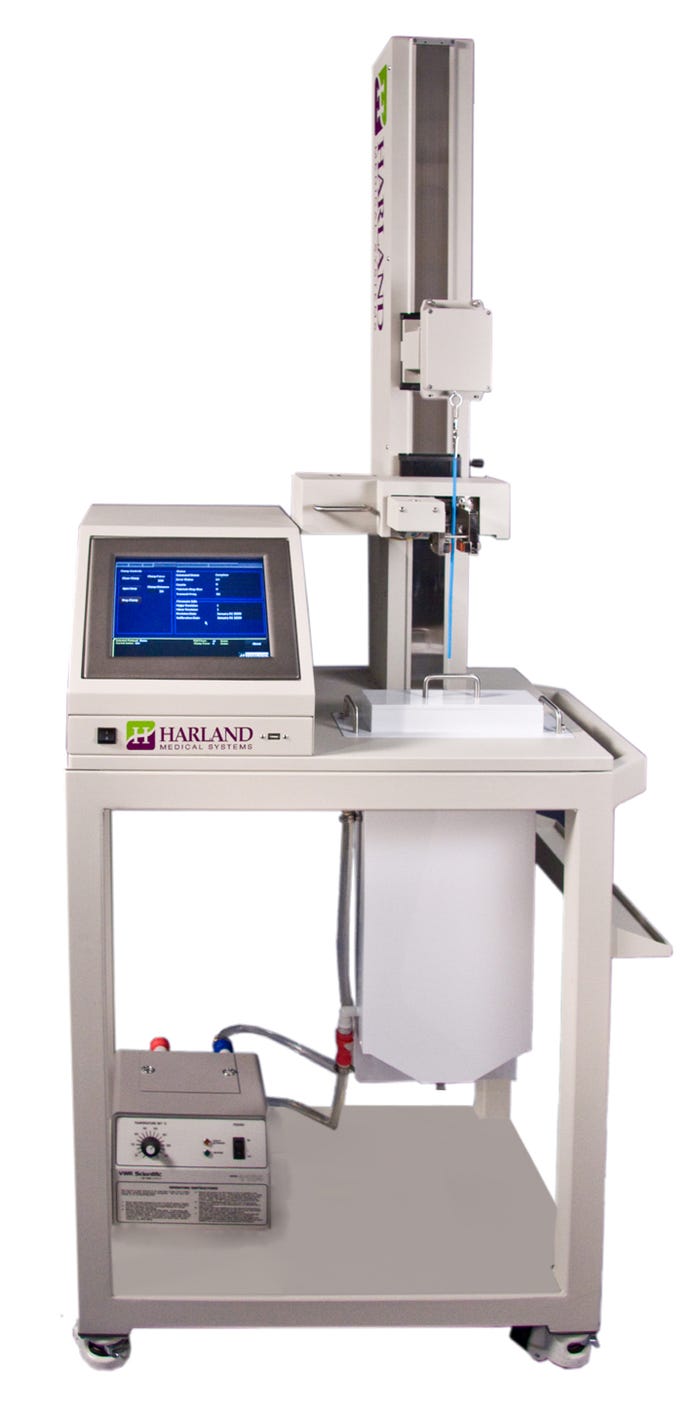June 6, 2017
Advances in medtech are giving those involved in surface coating a few new issues to consider.
|
Harland's FTS 6000 Friction Test System measures both surface friction and coating durability. |
The bar is being raised for surface treatment in medical device manufacturing. Surfaces have typically been coated or treated to enhance product lubricity and durability, but new trends in medical device manufacturing could present some challenges.
For instance, new "multimaterial devices with as many as six different material types on a single device makes versatile coating a priority," explained Andrew Summerville, vice president of marketing for Harland Medical Systems, a provider of surface treatment systems.
Trends also point toward demand for low-particulate-generation hydrophilic coatings, he added. "As coated catheters have been utilized in more demanding vasculature (like neurological and small coronary vessels), the requirements for low particle generation from coatings has become more and more important," he told Qmed.
And as outsourcing continues to grow in popularity in medical device manufacturing, coating processes, too, are being outsourced to coating service providers. These companies need "optimized processes to provide maximum coating performance and yet robust for production environments," he added.
Summerville believes these trends could challenge surface treatment operations in five key ways and offers potential solutions offered by Harland. The company will be discussing its approach at MD&M East June 13-15 at Booth #1166.
Challenge 1: Dedicating the resources required to develop the surface treatment/coating application process.
Coating method development includes processes and protocols that effectively and efficiently apply medical device coating to materials, Summerville explained. "The application process is just as important as the coating solution in providing optimum medical device coating performance," he told Qmed.
Harland works with customers to complete a feasibility to prove the coating method is successful and meets the device requirements, he reported. "This work is best left to those with the widest experience preparing coating processes," he said, adding that Harland's "Start Now" coating method development provides all the resources required to develop the coating process. "Harland's step-by-step 'Start Now' method development program provides a coating process that not only meets the customer's durability and lubricity performance requirements, but also is robust enough for the production environment."
Challenge 2: Meeting device surface treatment performance requirements.
Device designers need to determine what performance parameters are crucial to satisfying their customers' needs and then find a surface treatment that will meet these requirements, Summerville explained. "Meeting all the requirements can be quite challenging," he said. "To succeed, they need to employ the best tools to measure these performance parameters."
Two key surface performance parameters include lubricity and durability, he explained.
"High lubricity is very important because it provides reduced friction forces compared with an uncoated device surface," he said. "This enhanced surface performance increases the device's ability to navigate through tortuous anatomical pathways, improves device control, reduces tissue damage, and adds to patient comfort."
And "durability is also crucial to the coating surface, but can be challenging at times," he said. "The ideal chemistry will provide the photochemical covalent bond to the substrate producing superior adhesion and wear resistance while minimizing particulate formation. Harland delivers durability to the device by combining superior chemistry with an optimized method to apply the coating."
Harland offers coating solutions, optimized coating processes, and test equipment to measure these new levels of coating performance. For instance, Harland's FTS 6000 Friction tester measures surface friction and coating durability.
Challenge 3: Surface treatment for difficult substrates.
Certain substrate materials can be very challenging to coat," Summerville said. "Harland's latest addition to the Lubricent family of UV hydrophilic coatings offers the ability to bond to difficult surfaces like polyimide and polyethylene. The new coating also bonds to a wide variety of base materials, making it ideal for devices with multiple base materials."
Challenge 4: Cost pressures.
"Every device market experiences cost pressures," he said. "Harland's business model and efficient coating processes help keep up with market demands." For instance, all of Harland's Lubricent hydrophilic coatings are UV cured for fast processing speeds and precise process control, he added.
Challenge 5: Lack of regulatory support for coating submissions.
Harland offers experienced in-house regulatory personnel to advise medical device companies on effective and efficient regulatory submissions, including those involving combination drug/devices, Summerville said.
At MD&M East Harland Medical will be introducing a new UV Hydrophilic Coating solution developed to meet medical device manufacturers' needs for adhesion and lubricity as well as low-particulate generation. "Achieving this level of durability without sacrificing lubricity requires more than just a unique coating solution," he said. "This performance also requires a coating process optimized for each unique device material and shape."
Summerville reports that "Harland-coated devices that have gone through the commercial coating method development at Harland have been granted market approval by both FDA and notified bodies throughout the world."
For more details, visit Harland Medical Systems at MD&M East Booth #1166.
Daphne Allen is executive editor of Pharmaceutical & Medical Packaging News and a contributor to Qmed. Reach her at [email protected] and on Twitter at @daphneallen
About the Author(s)
You May Also Like





